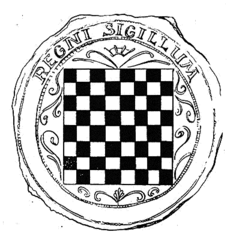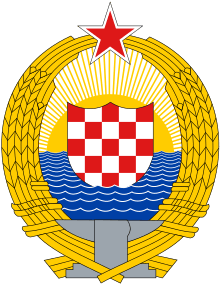Croatian checkerboard
Croatian checkerboard or chequy (Croatian: šahovnica, pronounced [ʃaxǒːʋnit͡sa])[1] is the national symbol of Croatia and Croats,[2] it covers the main shield of Croatian coat of arms above which is the crown with five smaller shields. Squares are always arranged correctly and they are red and white.[3] It is considered to be one of the oldest national symbols in Europe.[4][5]

Name
Croatian checkerboard or chequy and sometimes known as Croatian chessboard is translated from Croatian šahovnica (from šah, "chess"). Kockovlje and kockice (both from kocka, "cube") are often referred to Croatian checkerboard which is incorrect because checkerboard is made from geometric shapes and not from 3D geometric objects.
History
Origin
There is a legend (probably from the 19th century) telling how Croatian king Stephen Držislav, was captured by the Venetians, and played a chess match in which his opponent was Doge Pietro II Orseolo. He got all three parties and thus gained freedom, and in some versions, power over the Dalmatian cities. He then incorporated the chessboard into his coat of arms.[6][7][8]
Use in coat of arms

One of the oldest coats of arms of the Croatian kingdom from 1495 is located in the Austrian town of Innsbruck and is located on the front of the temple hall of Herzog-Friedrichstrasse 35. It is assumed that the creation of the Croatian coat of arms was stimulated by the emperor Maximilian I from whose time it originated the coat of arms of Innsbruck, but also some other coats of arms, preserved in today's Germany and Austria.[9][10][11][12][13][14][15] It is also assumed that the number of preserved Croatian shielded coat of arms from the time of the Habsburg ruler should be thanked to the fact that the Peace of Pressburg from November 7, 1491 gave him and his house the inheritance of the Hungarian-Croatian throne in case Jagiellonian dynasty would not have legitimate male offspring, but also the stipulation that Maximilian I could keep the title of the Hungarian (and Croatian) king. For this reason, it would not be strange that he had just spurred the emergence of a Croatian chess coat, if it did not exist before. The Habsburgs, however, became Hungarian-Croatian kings only a few decades later, so it is more likely that the then-ruling Jagiellonian dynasty were to commemorate the use of that coat-of-arms.
In some quotations it is mentioned that the white color indicates White Croatia and Red Croatia. There is also a belief in the meaning of the color of the first field in the coat of arms, according to which the first white field is the independence of Croatia, and the first red field is its subordinate position, but this belief is of the newer date and does not have any confirmation in earlier lore.[16][17][18]
Other uses
Typical red-white checkerboard is widely used on airports because of its recognizability and visibility. Checkerboard is used on roofs, water towers and other buildings around the airports.[19][20] However, the use is not directly connected to national symbol of Croatia and Croats. Croatian Air Force MiG-21 UMD is painted in red-white Croatian checkerboard. Jerseys in sport events that use Croatian checkerboard are widely used by Croatian sport fans. Croatian checkerboard can be seen on various objects as a decoration.
Gallery
 Croatian chequy on church in Baška
Croatian chequy on church in Baška Coat of arms of Croatia used in 1527 as part of a seal on the Cetingrad Charter.
Coat of arms of Croatia used in 1527 as part of a seal on the Cetingrad Charter. Kingdom of Croatia (1525-1868).
Kingdom of Croatia (1525-1868). Coat of arms of Croatian Crown land (until 1868)
Coat of arms of Croatian Crown land (until 1868)_(1868-1918).svg.png) Kingdom of Croatia-Slavonia (1868–1918).
Kingdom of Croatia-Slavonia (1868–1918)..svg.png) Coat of arms of Transleithania (1868-1915).
Coat of arms of Transleithania (1868-1915). Patriotic badge from 1914
Patriotic badge from 1914 Banovina of Croatia (1939–1943).
Banovina of Croatia (1939–1943). Banovina of Croatia greater version (1939–1943).
Banovina of Croatia greater version (1939–1943). Independent State of Croatia (1941–1945).
Independent State of Croatia (1941–1945). Socialist Republic of Croatia (1947–1990).
Socialist Republic of Croatia (1947–1990)..svg.png) Early coat of arms of the Republic of Croatia (1990).
Early coat of arms of the Republic of Croatia (1990).
See also
- Croatian coat of arms
- Check (pattern)
References
- "šahovnica - Hrvatski jezični portal - Znanje". Retrieved 20 July 2017.
- "GRBOVI I DRESOVI EURA Kako je šahovnica postala simbol Hrvatske". Archived from the original on 23 July 2017. Retrieved 20 July 2017.
- "Je li šahovnica hrvatski grb? - Portal Hrvatskoga kulturnog vijeća". Retrieved 20 July 2017.
- "Postoje dokazi da Hrvati nisu Slaveni, već jedini narod koji je svoje korijene sačuvao 6500 godina". Retrieved 20 July 2017.
- "Je li šahovnica hrvatski grb? - Portal Hrvatskoga kulturnog vijeća". Retrieved 20 July 2017.
- "Legenda o nastanku hrvatskog grba - mojapovijest.com". Retrieved 20 July 2017.
- "Hrvatska šahovnica - povijest i njegovo značenje". Archived from the original on 10 February 2017. Retrieved 20 July 2017.
- "Legende o hrvatskom grbu - Povijest.hr". Retrieved 20 July 2017.
- "HERALDIČARI I POVIJESNA ZNANOST NE MOGU SE NAČUDITI OPTUŽBAMA DA JE PRVO BIJELO POLJE ZLOČINAČKO Je li hrvatski grb iz 1495. - USTAŠKI?!". Retrieved 20 July 2017.
- "KAKO SRUŠITI CRKVU SV. MARKA NA GORNJEM GRADU?". Retrieved 20 July 2017.
- "O hrvatskim simbolima - OoCities". Retrieved 20 July 2017.
- "Prilog povijesti državnog grba Hrvatske i njegov najstariji prikaz u Innsbrucku". Retrieved 20 July 2017.
- "Elementi hrvatske kulture za Ukrajince - Croatian History". Retrieved 20 July 2017.
- "Knjižnice grada Zagreba - Hrvatski nacionalni simboli". Retrieved 20 July 2017.
- "Croatian coat of arms till 1600 - Croatian History". Retrieved 20 July 2017.
- "Flags Symbolizing Hatred - Journey East". Retrieved 20 July 2017.
- "THE STORY BEHIND THE CHECKERS (AND A FEW LINES ON EMBLEMS AS WELL)". Retrieved 20 July 2017.
- "Hrvatska šahovnica - povijest i njegovo značenje". Archived from the original on 10 February 2017. Retrieved 20 July 2017.
- "Why do many airports have red and white checkered structures?". Retrieved 20 July 2017.
- "Why is everything in Airports painted with red and white checks?". Retrieved 20 July 2017.
